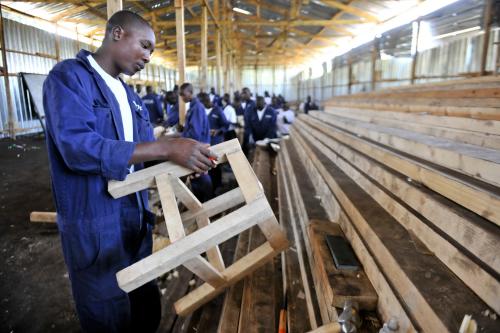Youth unemployment has been inordinately high for many years in South Africa and is one of the country’s major socio-economic challenges.[1] Cross-country comparisons regularly affirm that South Africa’s unemployment rates are among the highest in the world. In 2013, the youth unemployment rate was 63 percent of the youth labor force (3.2 million individuals) according to the expanded definition of unemployment, which includes as unemployed those who are not actively looking for a job (i.e., the non-searching unemployed, or “discouraged work-seekers”). Youth unemployment is high, even in comparison with South Africa’s very high average unemployment rate of 34 percent. (By international comparison, while the ratio of youth to adult unemployment is fairly similar for other countries that are economically comparable to South Africa, the overall unemployment rate is far higher than in other emerging markets.)[2] Of the 10.2 million individuals aged between 15 to 24 years, one-third are not in employment,[3] education or training (and are often referred to as “NEETs”). Roughly 30 percent of male youth and 36 percent of female youth are NEETs, disconnected from both the labor market and opportunities that promote future employability.
Unemployed youth are characterized by their lack of employability resulting from a range of socio-economic factors. They often have low levels of education, have dropped out of school and invariably do not have the literacy, numeracy and communication skills needed in the labor market. They also have little work experience, which is a particularly undesirable characteristic for employers. These young people lack strong networks or social capital that allow them to source job opportunities, and tend not to have sufficient financial resources to enable mobility to areas where there is demand for labor. Of those who do have resources available as a result of their family support or network, they often have unrealistically high reservation wages, thereby resulting in relatively long periods of unsuccessful searching (Mlatsheni, 2007; Von Fintel and Black, 2007; Rankin and Roberts, 2011; Roberts, 2011). These socio-economic factors have resulted in a gap between productivity and entry-level wages for young workers, which is a constraint on job creation.
Persistently high unemployment suggests a lack of effective policy interventions. To date, policies that have been implemented have largely been supply-side initiatives aimed at the structural causes of youth unemployment. These include targeting the formal education system, post-school training, public employment and deployment programs, entrepreneurship interventions and an attempt at job placement programs. From the demand side, an employment subsidy has been recently proposed by the National Treasury to incentivize employers to hire young people.
Supply-Side Policies Targeting Unemployed Youth
Challenges within the South African education system are key structural issues underlying youth unemployment. In short, school-leavers do not exit the system with the requisite skills demanded by the labor market. For this reason, a number of funding and policy interventions are aimed at improving the education system such that it would raise youth employment prospects. In the National Treasury’s budget for the 2013/14 fiscal year, education spending increased to 232.5 billion rand (R) ($21.8 billion), targeting infrastructure, services and the backlog in numeracy and literacy skills. However, there are large cohorts of young people that have already been impacted by weaknesses in the education system. This group of early school-leavers, dropouts and unemployed high school diploma-holders requires interventions tailored to their particular needs and characteristics if they are to be fully able to participate in the economy.
A number of skills and training programs have been set up through various publicly funded technical and vocational education and training (TVET) institutions with the aim of facilitating entry into the labor market. These institutions—known in South Africa as further education and training colleges (FET)—have been unable to ramp up capacity and provide the types of training required by the economy. TVET institutions primarily provide vocational education programs, but these do not necessarily meet the skills—such as completing a school qualification or training in a particular non-vocational skill—demanded by youth. TVET institutions are also not always easily accessible in terms of location or financing, as there seems to be less financial support than is available for tertiary education. Furthermore, partnerships between TVET institutions (and other educational institutions) and employers are weak, demonstrated by the falling number of apprenticeships[4] offered in recent years after graduation.
The trajectory of labor demand in the South African economy favors skilled workers and, in light of the limited job opportunities available for low skilled workers, the government has implemented publicly funded programs that offer (i) employment in the provision of essential basic services to vulnerable South Africans; and (ii) deployment in programs that can provide income while additional skills are developed, thereby improving future employability.
The Community Works Program (CWP) was rolled out in 2008 and is designed as an employment safety net whereby a person’s existing livelihood is supplemented by offering a basic level of income through work. The program is a direct replica model of India’s Mahatma Gandhi National Rural Employment Guarantee Act (NREGA) program. This program has been used in the poorest communities and complements the social grant system. Communities play a central role in determining the types of work created through this program by deciding what activities would benefit them most. This program was extended to the Extended Public Works Program (EPWP). While these programs are not geared directly to youth employment, the EPWP reported that 57 percent of CWP participants in 2010/11 were under the age of 35 years (Department of Cooperative Governance, 2011:2).[5] However, these programs have been found to be less attractive to youth because they are not tailored to youth aspirations. Further, this type of work experience, which includes repairing community or school infrastructure, creating food gardens or home-based care, often does not lead to better paying jobs in the labor market, particularly those in urban areas.
Public deployment programs have only been implemented in South Africa to a limited extent through the National Youth Development Agency (NYDA), which targets unemployed youth and the unskilled. The NYDA ran a 12-month program that trained young people, providing them with qualification credits in fields, such as construction or enterprise development, where labor demand was stronger. While the NYDA annual report presents evidence of meeting their targets for the 2012/13 financial year, these targets were set particularly low: For example, they set a target of 800 job placements (just over 3,000 were actually created).
The National Rural Youth Service Corps, targeting rural youth, was implemented in September 2010. The intervention comprised a comprehensive two-year skills and incubation program after which participants would be involved in community development projects and be paid by government for their services. Training was conducted in numeracy, literacy, construction and entrepreneurship skills relevant to community development. This, it was hoped, would stimulate the rural economy. While this project was seen to be somewhat successful, there was an oversight on the part of the program coordinators who underestimated the amount of training required for youth to actually take on the community projects. The project will, however, continue to run into its second phase in the near future. Future iterations of this program should work toward scaling up the training that facilitated employment in the previous round.
There have also been policy attempts at targeting youth entrepreneurship. The NYDA in particular plays a role in funding and facilitating youth cooperatives and provides training and support to youth entrepreneurs. These services are, however, not well targeted with very few young people accessing the services offered. Often interventions such as these are not pitched at the correct level or are offered to a community that does not demand these skills.
Apart from programs targeted specifically at young people, unemployed youth also benefit from general programs, given that they constitute the majority of the unemployed. One such example is the system of sector education and training authorities (SETA), which play a pivotal role in skills development in South Africa. Of particular relevance to young people is the learnership program, which allows the achievement of a nationally recognized qualification through a combination of structured learning and practical work experience. Learnerships involve individuals being placed within workplaces and are open to both students and the unemployed. Another example of a general program that benefits youth employment is the Department of Trade and Industry’s small business support programs.
The Department of Labor also aims to create an enabling environment for job creation through regulation. The Employment Services Act was passed in April 2014. The purpose of this legislation is essentially to promote employment, to improve the prospects of those looking for work by training and to facilitate job matching. In terms of youth, it aims to provide specialized services to access work with government requiring registration of job seekers as well as job vacancies and other placement opportunities and acting as an intermediary. Given very high cellular telephony penetration rates in the South African market, there seems to be extensive scope to explore available technologies to improve the accessibility—and, indeed, the evaluation—of such services.
South Africa’s Jobs Fund represents a significant intervention aimed at reducing unemployment generally. Launched in mid-2011 by the South African minister of finance in response to the loss of more than one million jobs in the wake of the global recession, this is the world’s largest challenge fund, with projects selected for funding through competitive processes with particular criteria relating to eligibility and impact. The fund provides public funding in four areas: enterprise development, infrastructure investment, support for job seekers and institutional capacity. The fund has created nearly 100,000 jobs at a cost of R63,000 (roughly $6,300) per job.
Demand-Side Policies Targeting Employers
In 2011, the National Treasury suggested that the high rate of youth unemployment was a result of insufficient demand within the labor market to meet the rising number of young job seekers entering each year. It is within this context of weak labor demand that the option of a youth employment subsidy has been proposed. Employment subsidies are appealing because they target job creation instead of indirectly incentivizing the absorption of youth into the labor market. They also offset the cost of employment and training of new workers for employers. Treasury is in favor of an employment subsidy as it operates through the tax system and can rapidly reach a scale that cannot necessarily be achieved through employment or deployment programs such as those discussed above. In terms of the proposal, employers who employ youth will be subsidized for two years, with a larger proportion of wages being subsidized in the first year.
Piloting of this type of initiative has yielded favorable results. Commissioned by National Treasury, the African Microeconomic Research Umbrella at the University of the Witwatersrand ran a pilot study with 4,000 participants from three provinces (Gauteng, Kwazulu-Natal and Limpopo). In terms of the experiment, half of the sample was given vouchers to cover up to 50 percent of their wage for six months and the rest of the sample group was given nothing. The key finding was that job seekers that had received vouchers showed a higher inclination to stay in a job, even after two years, thereby showing the positive impact of the voucher even after it had lapsed.
Unemployed youth differ widely in terms of demographic, locational and educational attainment characteristics, and it is a concern that the subsidy may not be inclusive in terms of targeting the youth (Yu, 2011: 16). Broadly, though, there are two key youth subgroups: First, those who are better off, have more work experience and are normally actively looking for a job; and, second, those who are located in poorer provinces, are less mobile, are more likely to have a lower level of education and who have no work experience. The latter group includes normally discouraged work seekers. There is concern as to whether the subsidy will actually encourage discouraged work seekers to actively look for a job and, furthermore, and whether this group would become any more attractive to employers. This policy will obviously have to work in conjunction with sector employment projects, training institutions and financial support for further education programs to have a wider scope in terms of the youth that will be targeted.
Conclusion
The South African government has implemented a number of initiatives aimed at creating jobs and reducing unemployment, as well as ameliorating the impact of high unemployment on individuals and their households. The past 20 years has seen a significant expansion of the existing social grants system that, while not specifically targeting the unemployed, has helped reduce poverty among households impacted by unemployment. Thus, by mid-2013, nearly 16.2 million social grants of various types were being paid by government on a monthly basis, equivalent to over 30 percent of the country’s population. Further, there is some evidence that social grants have helped facilitate job search among unemployed household members.
There is general recognition, though, that government alone cannot resolve the unemployment crisis. As a result, there are now a significant number of ongoing interventions spearheaded by organizations in the non-governmental and non-profit spheres. These interventions range from small business support, to youth training, to the provision of bursaries for education and training, to facilitating the matching process between job seekers and employers.
In summary, there are certainly concerns around South Africa’s youth unemployment policy interventions in terms of design, targeting and ability to adequately address the needs of young labor market entrants as well as employers. Perhaps the key constraint in generating impact has been scalability, as many interventions have been too small or too localized to impact aggregate unemployment rates. An important lesson is that supply-side initiatives addressing structural issues are insufficient on their own to generate sufficient new jobs. Instead, these interventions should interface closely with demand-side incentive programs. There are, also, political economy constraints that need to be resolved. For example, the generalized lack of jobs results in resistance to certain interventions on the part of those who view them as a zero-sum game between the youth and older workers.
Note
: Morné Oosthuizen is the deputy director of the
Development Policy Research Unit (DPRU)
at the University of Cape Town. DPRU is one of the Brookings Africa Growth Initiative’s six local think tank partners based in Africa. This blog reflects the views of the author only and does not reflect the views of the Africa Growth Initiative.
[1] Youth are defined by the International Labor Organization as individuals between the ages of 15 to 24 years. It is important to note, however, that South Africa utilizes a broader definition, covering individuals between the ages of 15 and 34 years, and its youth-targeting policies focus on this broader age group. However, for the sake of comparison, we use the international definition unless otherwise stated.
[2] The National Treasury (2011) used the ILO and QLFS 2010 to make this assertion for the 18-29 age cohort. The ratio of youth to adult unemployment in Africa is about 2.5 (i.e., the youth unemployment rate is two and half times larger than the adult unemployment rate), and cross-country comparisons indicate that this is broadly in line with other emerging markets such as Morocco, Mexico and Chile. South Africa was an outlier in terms of the magnitude of the unemployment rate. It was just under 40 percent while other emerging markets varied between 10 percent and 30 percent.
[3] Youths “not in employment” are not considered members of the youth labor force because they are not economically active.
[4] Between 2008 and 2009, the number of apprentices declined 25 percent from 12,000 to 9,000 placements (Janse et al. 2012:45).
[5] Department of Cooperative Governance (2011). Communities at Work: Community Work Program 2010/2011. Pretoria: Department of Cooperative Governance.
The Brookings Institution is committed to quality, independence, and impact.
We are supported by a diverse array of funders. In line with our values and policies, each Brookings publication represents the sole views of its author(s).







Commentary
The State of Youth Unemployment in South Africa
August 15, 2014